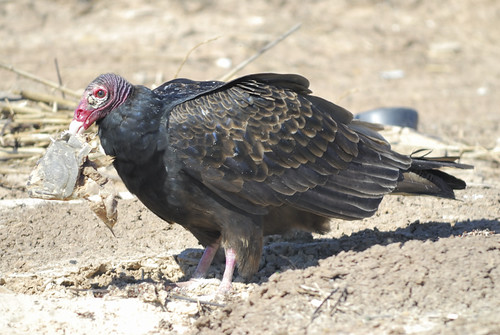tags: Turkey Vulture, Cathartes aura, birds, mystery bird, bird ID quiz
[Mystery birds] Turkey Vulture, Cathartes aura, photographed the Quintana Beach and Jetty area, Texas. [I will identify this bird for you tomorrow]
Image: Joseph Kennedy, 18 November 2008 [larger view].
Nikon D200 1/250s f/8.0 at 1000.0mm iso400.
Please name at least one field mark that supports your identification.
Rick Wright, Managing Director of WINGS Birding Tours Worldwide, writes:
Compare this fine Turkey Vulture with the Black Vulture in an earlier quiz. Sure, the head color gives it away, but notice that there are plenty of other differences we can use to distinguish these species even when we can't see that distinctively small, bright head of a Turkey Vulture.
Note first how inelegant this bird is on the ground. Where Black Vulture is neatly proportioned, Turkey Vulture has a grotesquely bulbous body and a ludicrously long, slim rear end -- due as much to the long secondaries as to the long, slightly wedge-shaped tail. The tarsus, a very useful mark on vultures perched above the observer (but not directly above, please: that can get messy), is clearly tinged pink, quite unlike the cold white or gray of a Black Vulture's foot. The upperparts show a visually rough pattern of bright brown edgings on glossy bluish feathers, unlike the restrained mourning worn by Black Vultures. In flight, these two species are almost never confused with each other; but the marks used to distinguish them on the ground are less widely known -- and eminently worth learning.


TV!!!
Big dark bird, big red head of the sort you wouldn't want to meet in a dark alley.
(Ever notice how I only know the birds an average 12-year old knows. /sigh)
Cathartes aura
Big red head, obviously not a turkey
Turkey vulture.
I recall reading a short story in Boy's Life when I was a kid about a boy who raises a turkey vulture. I don't remember much about it, except that it made me look at vultures with new eyes, as birds that were victims of an irrational discrimination based on our disgust with their feeding behavior.
We have about 20 or 30 of them that roost above the "Artist's Passage" at the Carpinteria Bluffs. It's interesting to see them coming in for the night, assembling in our bedroom community, back from their wide-ranging daily commute. I guess I identify with that, on some level.
Definitely a turkey vulture. Wow, a non-parrot bird I can identify!
Naked red head; brown body feathers; large body - definitely a Turkey Vulture.
Yep turkey vulture. I can't wait for ours to come back and eat the dead deer in our pasture. They roost about half a mile from my house and always sun themselves on our roof or fence posts.
Naked head, hooked beak, red wrinkled skin; vulture. Location plus large nostril suggest New World vulture to me. Lack of: crest/wattles/punk-rocker-looking stuff on the beak (excludes King Vulture), wispy feathers around the neck (excludes condor) and lack of yellow coloration on the face excluding the other two Cathartes species. Concur with the "turkey vulture" assessment.
Hmmm...looks like it's working on some stinky unpleasant dead thing. Yummm.
I love these birds - there are some roosting on the water & microwave towers near my father's. I got some nice pics of buzzards the other day, in fact.